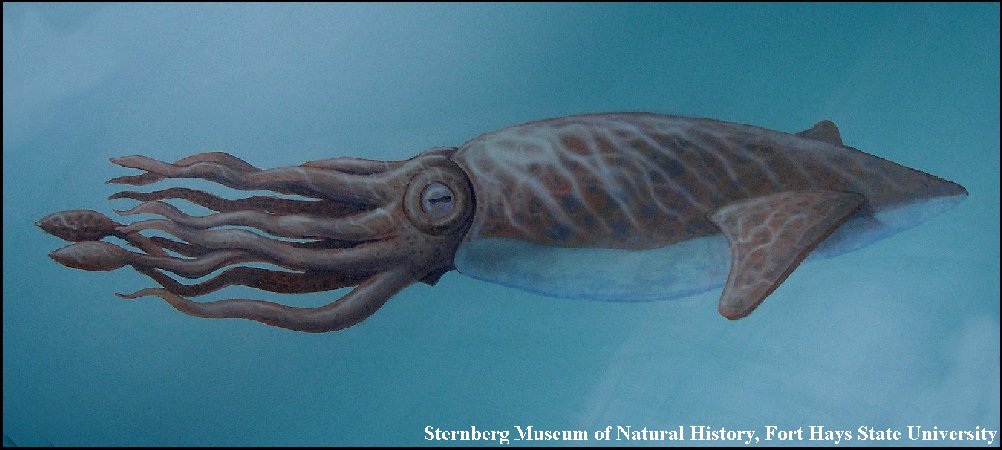
In Search of Tusoteuthis longa, the Elusive Niobrara Squid
Copyright © 2011 by Mike Everhart
Created 07/15/2011; Last revised 08/12/2012
Left: A painting of Tusoteuthis in a diorama at the Sternberg Museum of Natural History in Hays, Kansas.
Squid (Teuthids): Squid are soft bodied invertebrates (cephalopods) that probably occurred in great abundance in the warm oceans during the Mesozoic. Occasionally, the internal structure (gladius or pen) of the squid is preserved. The fossil remains of squid are characterized by long, straight fibers or strands that often appear to be iridescent. Squid remains are sometimes mistaken for an unusual fish bone. CLICK HERE FOR MORE INFORMATION
 |
LEFT: Tusoteuthis, a 'giant' squid that lived in the Western Interior Sea, may have been as long as 25 ft. (7.5 m), although there is little or no proof of their size because so little of their body is preserved. In any case, it probably wasn't nearly as large as shown in this dramatic painting in the University of Kansas Museum of Natural History. The evidence of bite marks in some squid pens shows that squid were eaten by many predators including fish and mosasaurs (Stewart and Carpenter 1990). Click here for a picture of a very large Tusoteuthis longa fossil from the Pierre Shale in the Museum of Natural History at the University of Kansas. Williston (1897, p. 242) was puzzled by fragments found occasionally in the chalk that were of a "glistening fibrous nature." A specimen collected by H.T. Martin (below) solved the mystery when it became apparent that the fragments represented a "large cuttlefish, apparently different from any described species. The specimen was about 6 inches wide and a foot long, and preserved a small "sepia bag" (ink sac) below it. |
Early in 2011, I was contacted by Trish Weaver, the collections manager of the North Carolina Museum of Natural Sciences. She was doing research on fossil squid trying to determine what fossil squid pens were composed of (chitin, chitinous or what?) and was looking for a sample to test. She also wanted to spend some time in the Smoky Hill Chalk, so we made arrangements to spend a day in the chalk and search for a specimen that she could use in her research. Neither of us really expected to find a specimen "on demand" but I thought there was a good chance of finding at least a fragment at the site where I had collected a specimen in May, 2011 (above). With that realistic goal in mind, we drove out to the locality early in the morning on July 8. The weather was actually unseasonably cool and cloudy for Kansas in July.... a great day to be in the field.
Our group included Dan Lawver, a Montana State graduate student, who was also from North Carolina. Neither of them had ever worked in the Smoky Hill Chalk, so I expected we would spend quite a lot of time just getting used to the chalk and all the inoceramid shell fragments at this locality. About half an hour into our search, Dan called me over and said he had found something. As I got closer, he said it was probably a root, but I was still hopeful. As it turned out, he'd nailed some squid remains almost as soon as he started looking...
The specimen will not be prepared for a while, but I will post new photos when they become available. I expect that this specimen would rate with some of the better specimens collected from the chalk in the last 120 years... there just aren't that many of them around.
Fast forward to 2012.... Trish and Dan came back to Kansas to see if we could repeat our earlier success... First day, no luck but by noon of the second day, we had another nice specimen of Tusoteuthis longa.
REFERENCES:
Everhart, M.J. 2005. Oceans of Kansas - A Natural History of the Western Interior Sea. Indiana University Press, 322 pp.
Green, R.G. 1977. Niobrarateuthis walkeri, a new species of teuthid from the Upper Cretaceous Niobrara Formation of Kansas. Journal of Paleontology 51(5):992-995.
Hoganson, W. 2006. Dinosaurs, sharks, and woolly
mammoths: Glimpses of life in North Dakota's prehistoric past. Journal of the Northern Plains 73(1-2):60 pp.
Larson, N.L. 2010. Fossil Coleoids from the Late Cretaceous (Campanian and Maastrichtian) of the Western Interior. Ferrantia 59:78-113.
Logan, W.N. 1898. The invertebrates of the Benton, Niobrara and Fort Pierre groups. The University Geological Survey of Kansas, Part VIII, 4:432-518, pl. LXXXVI-CXX.
Miller, H.W., Jr. 1957. Niobrarateuthis bonneri, a new genus and species of squid from the Niobrara Formation of Kansas. Journal Paleontology 31(5):809-811.
Miller, H.W., Jr. 1968. Invertebrate fauna and environment of deposition of the Niobrara (Cretaceous) of Kansas. Fort Hays Studies, n. s., science series no.8, i-vi, 90 pp.
Nicholls, E.L. and Isaak, H. 1987. Stratigraphic and taxonomic significance of Tusoteuthis longa Logan (Coleoidea, Teuthida) from the Pembina Member, Pierre Shale (Campanian), of Manitoba. Journal of Paleontology 61(4):727-737, 5 figs.
Stewart, J.D. 1976. Teuthids of the North American Late Cretaceous. Kansas Academy of Science, Transactions 79(3-4):74 (Abstract).
Williston, S.W. 1897. Niobrara Cretaceous. The University Geological Survey of Kansas 2:237-246.
Stewart, J.D. and Carpenter, K. 1990. Examples of vertebrate predation on cephalopods in the Late Cretaceous of the Western Interior. pp. 203-208 In Boucout, A. J. (Ed.), Evolutionary paleobiology of behavior and coevolution. Elsevier, New York.
Williston, S.W. 1897. The Kansas Niobrara Cretaceous, The University Geological Survey of Kansas, 2:237-246.